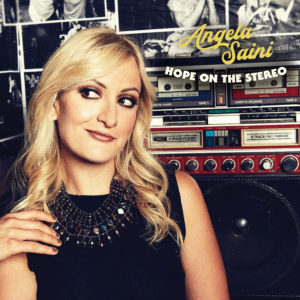
At the tender age of 15, Angela Saini joined a group of hungry young fellow musicians from western Canada and started her creative journey within the often unpredictable world of the music industry. The band would eventually move to Toronto, and release four albums under the name Supernal, including the critically acclaimed alternative, electronic rock record Drive Faster – the band’s last – released in 2010.
With more than a decade under her belt as a musician and vocalist, Saini ventured forth as a solo artist in 2012, with her debut EP Cake and Callouses. Since then she has released a series of wonderfully compelling singles and EPs, each one reflecting her personal growth as a musician and writer, and her growing comfort within the Americana genre.
Her latest album, Hope on the Stereo was released in late March, and features seven instantly memorable and delightful tracks, all of which feature Saini’s unmistakably ebullient delivery, and exceptional skill in melodic music making.
As a solo artist, Saini has continued to evolve and also take a firmer grasp her independence more and more with each release. Hope on the Stereo sees her taking the proverbial bull by the horns as a co-producer alongside Guillermo Subauste. She also allowed more ‘reality’ to seep into both the writing and production, as Saini wanted the album to be more of a balanced take on the ups and downs of life, while still retaining her trademark sense of optimism and positivity.
“I really knew what I wanted this time and I took my time in making it. I had 39 songs and it took about three years to pare it down. I did all the demos in my own home studio, and J just really got the confidence of knowing exactly what I wanted and took my time with the songwriting. I decided to work with Guillermo because I knew it would be a good pairing; he has a great studio here in Toronto that we used and recorded live off the floor with my band [Pacha Sound], and then I did a lot of the overdubs and vocals in my own studio. That’s where I really got to let my creativity take off and the whole experience was very freeing, I could play guitar or sing exactly what I heard in my head, and then Guillermo and I would come back together and make everything sound great. I have never done anything like this before: usually I would have the material and go to someone else and say, ‘make this sound great.’ This time I had a big part in everything,” Saini explained.
 “And I think not only this album, but every album is different, mainly because I am always still evolving as an artist. I have always been Angela Saini, but I have only been Angela Saini as a brand since 2012, when I left my long-time rock band, so I am still finding who I am as an artist. All artists aspire to evolve because if we just put out the same stuff every time, I don’t know if that would be fair to ourselves. We’re allowed to grow and learn with every song that we record and release. The biggest thing for me this time was I wanted to try something I hadn’t done before and that was the producing. But I also wanted to explore more facets of life.
“And I think not only this album, but every album is different, mainly because I am always still evolving as an artist. I have always been Angela Saini, but I have only been Angela Saini as a brand since 2012, when I left my long-time rock band, so I am still finding who I am as an artist. All artists aspire to evolve because if we just put out the same stuff every time, I don’t know if that would be fair to ourselves. We’re allowed to grow and learn with every song that we record and release. The biggest thing for me this time was I wanted to try something I hadn’t done before and that was the producing. But I also wanted to explore more facets of life.
“Living on the Bright Side is probably my most well known song and a lot of people see the positive side of who I am and that’s a real person. I am certainly a positive person. I like to live on the bright side, so that song is certainly a reflection of who I am. When it came to this new album, I really wanted to convey both sides of the coin. I like to describe Hope on the Stereo as an exploration of light and darkness, and the shades in between, with lots of autobiographical stuff in there. Hope always comes out on top, because I am wired to be a positive person. But I also wanted to explore those shades in between light and darkness because I have gone through that myself over the time that I have been making this album.”
And it’s a process that works, as Hope on the Stereo can’t help but put a smile on a listener’s face at the end of listening to all the tracks, because the emotional journey is more complex, very real, but ultimately a fulfilling one for both Saini and the audience.
“Some of the songs I chose to record show that journey, because we all know that not everything in life is puppies and roses. That’s not life, that’s not real. It was a conscious choice and another big difference from anything I have done before. It’s a journey of where I have come from as an artist and as a songwriter in the last little while, and now I have this collection that kind of comes full circle and is not just one sided,” Saini said, also asserting that one thing that will never leave her music is the importance of self-empowerment.
“It’s taking ownership of the good and the band in life and everything in between, which helps you move forward. Every day is a choice, and I truly believe that. It shows in my song selection; I am trying to empower an audience at the end of the day, so I think the song selection on this album reflects that. What I want the listener to get out of it is hope. Not despair, not frustration or any of those negative things, it’s more about how we move past those things, which are struggles everyone faces and some point in their lives.”
Saini is in many ways an inspirational songwriter, in that sparks of ideas come to her often. The craft is in taking those initial sparks and applying her considerable skills as a composer and lyricist to create compelling songs.
“There is no one way I do things. But more often than not I start with a guitar part or a chord progression of some kind. I like to noodle on the guitar and that’s where a lot of my ideas come from. Once in a while lyrics come first. I do think I have good songwriting habits; I am writing all the time – whether it’s good or not is another factor. But I do come to a song in many different ways,” she explained, and she also discussed how much more co-writing she is doing these days.
“Sometimes I wake up with a melody in my head; that’s something that happens a lot and I try to put the music to that. That’s a little more difficult than just starting with something on guitar, because I would just be jamming at home anyways. Hope on the Stereo has the most co-writes on it than anything I have ever done before and I am doing more co-writing in general than I have ever done before. It’s mainly because I like to have a lot more songs to choose from. I love producing more music and writing only by yourself, I find, can be a bit of a slower process because I am not good enough or fast enough on my own as a writer. When you’re working with someone else, you get to work with their strengths and then my strengths can shine.
“As a songwriter, and I am sure a lot of people can attest to this, its easy to start a song, but it’s much harder to finish a song. And that is my Achilles heel sometimes. If I am working on something entirely myself, the verse is easy and the chorus usually comes together but if I haven’t written a bridge yet, that means the song might not see the light of day because the bridge is often the hardest part for me to come up with. Generally speaking, once I have got a song finished, I will put it with the others and then decide if I am going to play it live. Songs are always living and breathing until they are in a fixed form anyways, and even then, I may change them up.”
There are a number of outstanding and compelling tracks on Hope on the Stereo, many of which fit in with Saini’s overall optimistic approach to life. Even the darker songs are imbued with a sense of hope and that circumstances can change – people can also change, as evidenced by the song Black Sheep.
 “I was in Nashville visiting a friend named Lori Kelley. I have known her for a long time and she and her husband moved down there and invited me to come visit. I did some other writing while I was there, but it wasn’t really a professional visit. Lori is my friend and we were just hanging out, talking about how people who aren’t, quote/unquote creative, don’t necessarily understand the things that we do, the commitment that we have to our craft and our art and the decisions that we sometimes make in order to protect it or move forward,” Saini said.
“I was in Nashville visiting a friend named Lori Kelley. I have known her for a long time and she and her husband moved down there and invited me to come visit. I did some other writing while I was there, but it wasn’t really a professional visit. Lori is my friend and we were just hanging out, talking about how people who aren’t, quote/unquote creative, don’t necessarily understand the things that we do, the commitment that we have to our craft and our art and the decisions that we sometimes make in order to protect it or move forward,” Saini said.
“She was saying how that we have to kind of go against the grain to do what we do – that was sort of the conversation. And the more we talked about it the more I thought of the notion of the black sheep. I have definitely been the black sheep in my family. The song really came together from that conversation and us really relating to one another, and also creating this anthem for people who might be afraid to be who they really are, or maybe aren’t embracing who they really are and have a hard time taking that first leap into the unknown. And I know it’s hard because I have done all those things. So that’s where that song came from, the idea of trying to get out of the box of what is expected of you and listening to your inner voice and dancing to the beat of your own drum.”
Of a similar emotional context is the thoughtful My Once Upon A Time, co-written with Japeth Maw, wherein Saini is opining that we shouldn’t allow our past and our memories to define who we are today, but that there is nothing wrong with looking back and enjoying the ride.
“The cool thing about our memories and where we have come from is that no one can ever take those things away from us. But it’s not about letting those memories define us in the present – they don’t make us who we are completely. But when you want to look at the things maybe you have done or the person you used to be, or maybe the person you still are, it’s such a beautiful thing to be able to look back to memories you cherish, because nobody can ever take those away from you,” Saini said.
“We carry those experiences and those aspirations and whatever else through our whole lives and I think there is something really beautiful about that.”
The upbeat, pop-infused Handrail is a song that takes as its premise the idea we are all wonderfully unique and joins it with the concept that as diverse and divergent as our lives, personalities and experiences have been, at our core we are still all human beings inhabiting the same space, the same community, the same planet – at the same time, and that we need to embrace that commonality more.
“The inspiration for that song came when I was on the subway in downtown Toronto and looking around at all of us and realizing that we’re all in this together – all the people on the subway train. It was a big epiphany simply riding the subway, as I have done thousands of times, and realising that if something happened to that train, we were all in it together,” she said.
“And no matter our differences, no matter our gender or race or socio-economic status or whatever, we are all actually the same. We are all on this path through life together. And the analogy of all of us being on a train, which you could use to apply to life in general, or to our lives being human beings on this one planet. I was really trying to capture the essence of that – that we’re all really one in the same. So, I love that imagery of a subway train and looking down the car and seeing all these different people. And that’s something that I love about Toronto: everybody and anybody lives here. Everyone is accepted and we all get along together. There is something that’s just so embracing about our society here and I just love it, and I wish it was something that could happen to people around the world – get that sense that we’re all together on this journey.”
In terms of Saini’s touring journey, she played a number of shows in Ontario to mark the release of Hope on the Stereo in March and April, and returns to Toronto for a date at The Cameron House on May 1 as part of a weekly residency and the venerable music venue throughout May, followed by a sojourn to the Ottawa Valley on May 4 for a show at the Batstone Northern Ramble. More dates will be announced as the summer festival season comes together
For more information on shows, Saini and Hope on the Stereo, visit www.angelasaini.com.
- Jim Barber is a veteran award-winning journalist and author based in Napanee, ON, who has been writing about music and musicians for a quarter of a century. Besides his journalistic endeavours, he now works as a communications and marketing specialist. Contact him at jimbarberwritingservices@gmail.com.
SHARE THIS POST:
